 Technology peripherals
Technology peripherals
 AI
AI
 Kavita Bala, Dean of Cornell School of Computing: What is the 'Metaverse”? God's Eye may be born through AI
Kavita Bala, Dean of Cornell School of Computing: What is the 'Metaverse”? God's Eye may be born through AI
Kavita Bala, Dean of Cornell School of Computing: What is the 'Metaverse”? God's Eye may be born through AI

This article is reproduced from Lei Feng.com. If you need to reprint, please go to the official website of Lei Feng.com to apply for authorization.
My research in the past few years has mainly focused on visual appearance and understanding, from micron resolution to world-class. Before I start my speech, let me show you a very interesting example. The visual interface between the protagonist and the world in this movie is very interesting.
You can see that when this person walks in the real world, a series of text appears on his visual interface. The protagonist is a car fan, so the visual interface shows him a wealth of information about the car:
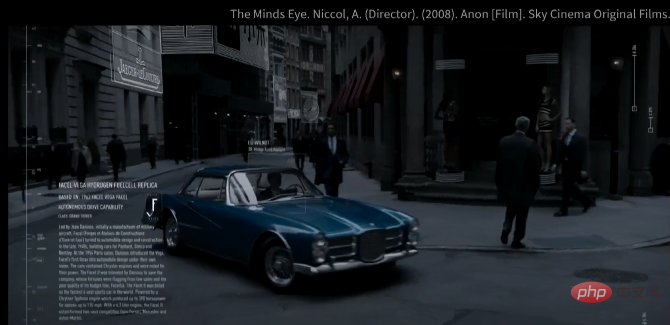
Only one photo is needed, and the visual interface is Can tell you all the information about this car. We need research in the fields of computer vision and visual understanding to advance this technology.
The protagonist continues walking, and when you get closer to these models, you will find that they are not real people, although they look very realistic. To achieve such technology, we need to study Realistic Appearance (Realistic Appearance).

Then the protagonist walked to a shopping window and saw all the products in the window. This time his visual interface shows him all the information about the product inside, and even simulates the effect of wearing the product. The protagonist can experience the product without actually touching it.

To achieve the effect of this video I show you, we need a method called "Inverse Graphics( Inverse graphics" technology can digitize all attributes of goods and interact with them.
I show these examples to show you the various technologies we are developing. You must have heard a lot about augmented reality/mixed reality. The ones I just mentioned are all is the technology now driving the development of augmented reality. Today I will focus on the visual technology.
A model that looks so realistic that you can't tell if it's real or fake is called photorealistic appearance in the field of computer graphics; there's another in this field Direction is to take a photo of an object and how do we understand all the attributes of the object in the photo; then we can continue to develop on this basis to understand the attributes of the world.
These are the three major contents I want to talk about today:
- Physically based visual appearance model (Physics-Based Visual Appearance Models)
- Inverse Graphics(Inverse Graphics)
- World-scale Visual Discovery(World-Scale Visual Discovery)
1 Physics-based visual appearance model
Let’s start with physics-based graphics.
First I would like to introduce a famous test: the Cornell box test, which is designed to determine the accuracy of rendering software by comparing the rendered scene with an actual photo of the same scene. The two pictures I show you, one is artificially rendered and the other is real - actually the left is a real scene and the right is a virtual picture.
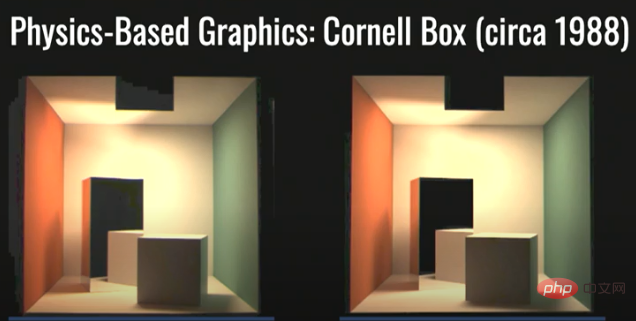
People have worked for years to create images that this test cannot detect as real or fake. But the real world is not as simple as the picture in Cornell's box. There are many kinds of materials in the real world, such as fabrics, skins, leaves, food, etc. shown in this picture. People are constantly interacting with the world and judging whether what they see is real. When we want to simulate the realistic visual effects of the model on the left below, how to represent these complex materials is a big challenge. This is also a problem I have studied for many years.
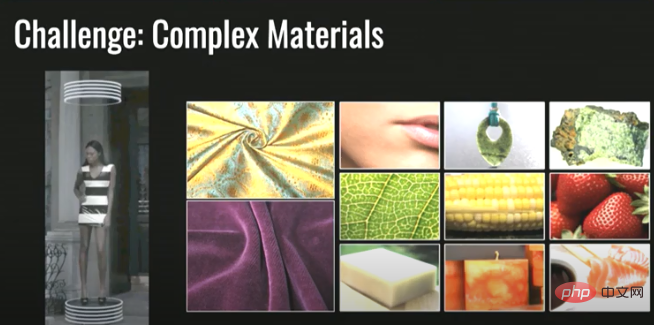
So I'm going to talk about how to properly capture the look of fabric and cloth. First, let’s ask a question. Look at these two pictures. As a human being, you can immediately recognize that the left is velvet, and the right is a shiny silk-like material. Why can you recognize it immediately? What makes velvet look like velvet, and what makes silk look different than velvet but look like silk?
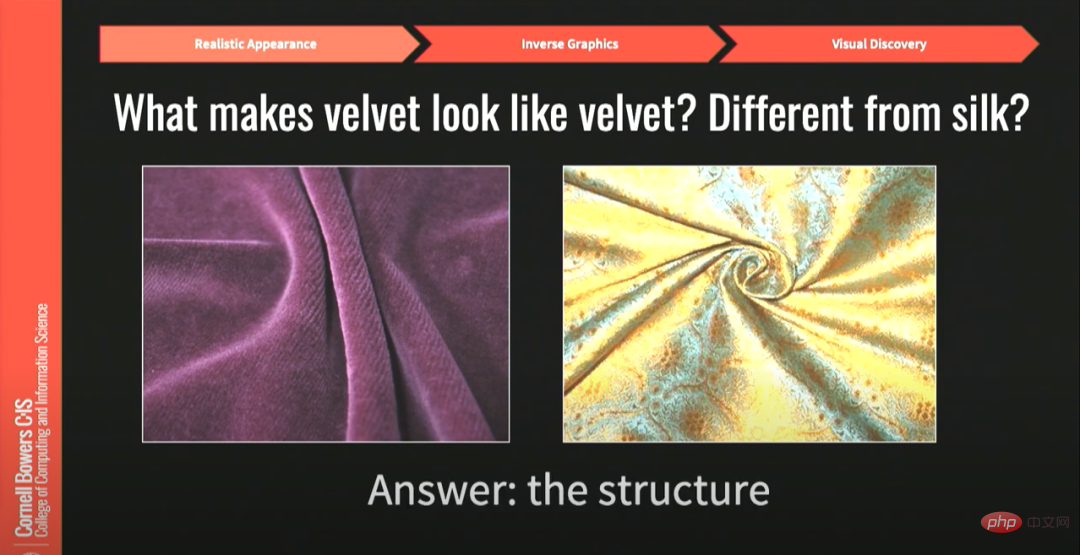
The answer is: structure.
The two fabrics are not only different in appearance, but their essence is that their visual effects are different because of their different structures. If we grasp this structure, we capture their visual essence.
So what we did in the original project was: look at micro-CT scans of these materials.
In the micro-CT scan of velvet, we can see that velvet is a furry material.
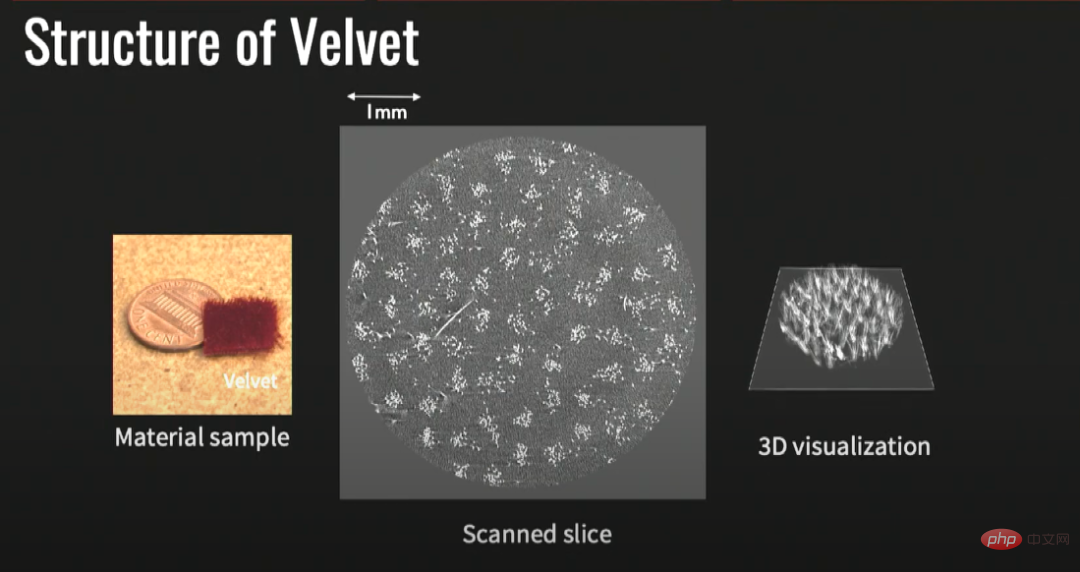
#The structure of silk is completely different. Silk is very tightly intertwined. The warp and weft form a specific pattern. Because the structure of silk is so tight, it gives silk that shiny effect.
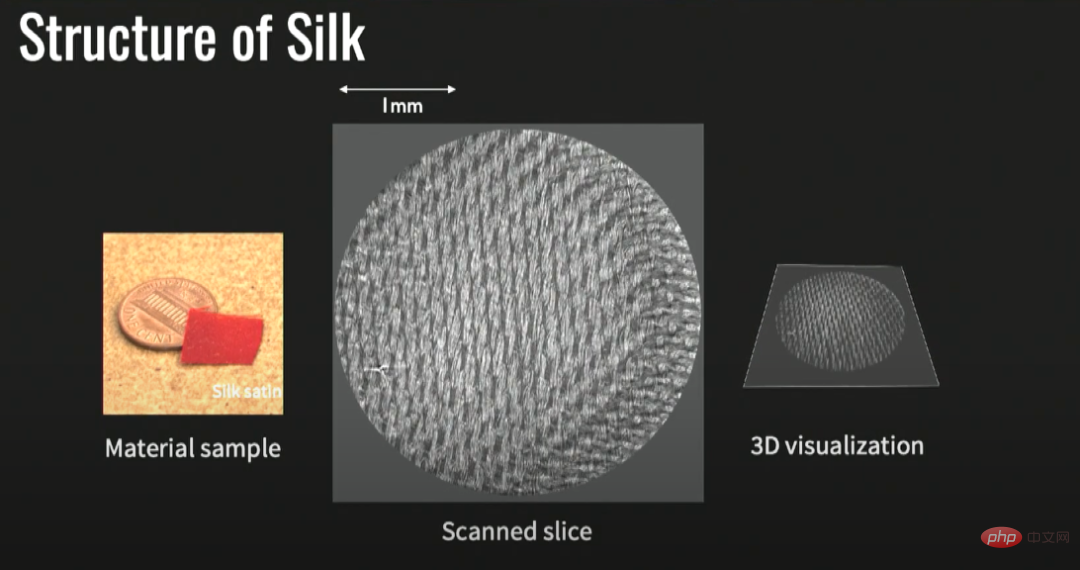
Speaking of this, we will find that as long as we grasp the microstructure of the material, we can basically grasp the appearance model of the material. Even if the material It's very complex, but it still remains true to its roots.
Once we grasp the structure, we can grasp the information that shows the optical properties, such as color. This information was enough to give us a complete model, allowing us to recreate the realistic visual effects of this material.
As shown in the picture, by mastering the structural characteristics of the two fabrics, we successfully restored the visual effects of velvet and silk.
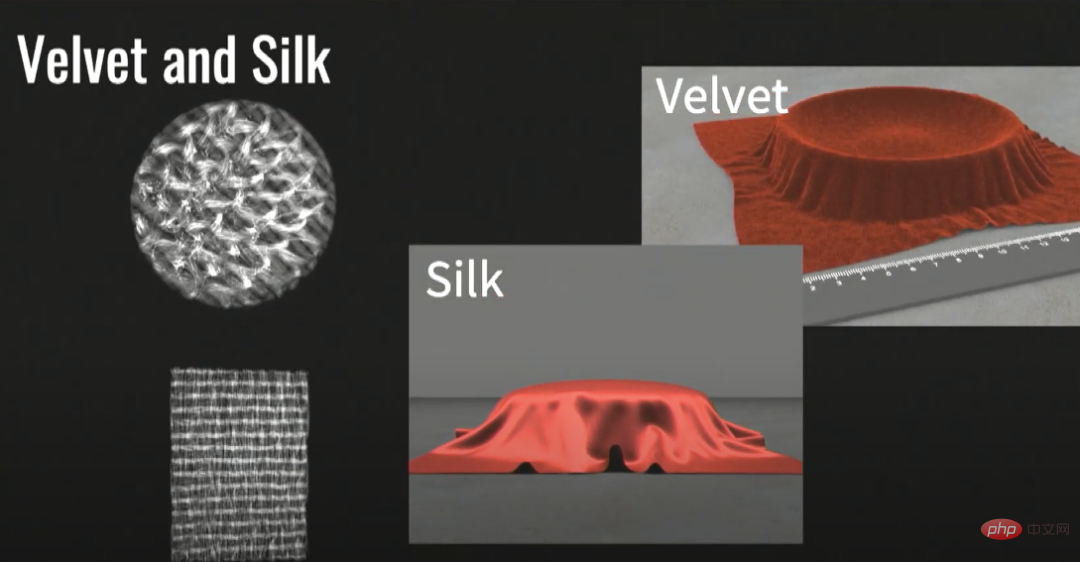
We have done a lot of research on actually promoting these models and thinking about what real-world applications this model can have. We now believe that this tool will make digital prototyping easier for industrial designers, textile designers, etc., giving designers the ability to simulate the appearance of real woven fabrics.
In an industrial loom, real yarn is used on the bobbin and after adding a weaving pattern, the industrial loom will produce a fabric as shown below on the right,and The modern visual Turing test we want to create is essentially a fully digital pipeline that uses a combination of CT scans and photos to achieve the same effect as an industrial loom.

This virtual yet realistic visual effect allows designers to make important decisions without actually manufacturing the fabric.
We actually created a low-dimensional model and 22 parameters that more intuitively represent the material structure. Designers will gain greater power if they can use this tool.
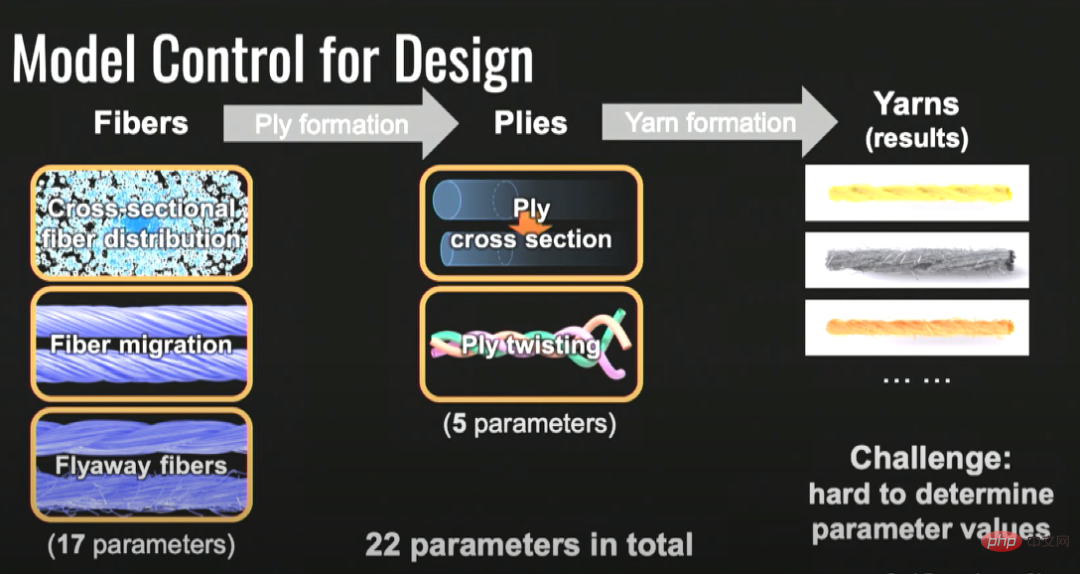
And these 22 parameters will lead to the second topic I am going to talk about, inverse graphics.
2 Inverse Graphics
The second problem we encountered is, after having these models, how to adapt to these models? ? This is also an important topic in computer graphics research.
Let’s start with the relationship between light and the surface of an object.
When light encounters a metal surface, the light will be reflected. As for other materials, such as skin, food, fabrics, etc., when light encounters their surfaces, the light will enter the surface and interact with the object to a certain extent. This is called subsurface scattering.

As shown in the picture above, the way to judge whether sushi is delicious is to judge the gloss and freshness of its appearance. Therefore, if you want to simulate the visual effect of a certain object, you need to understand what happens when light hits the surface of such an object.

Caption: End-to-end pipeline
Under ideal conditions , we have some kind of learned representation. After taking a photo, we can identify what material properties and material parameters the objects in the photo have. We can also know three parameters related to different scattering: How far it travels in the medium, how much it spreads, what is the albedo of the material when it is scattered, etc.
And now that we have very good physically-based renderers that can simulate the entire physical process of light hitting the surface of an object, I think we already have the ability to create this kind of pipeline.
If we combine the physically based renderer and the learned representation to get this end-to-end pipeline, and then match the output image with the input image and minimize the loss, then we can get the material Properties (that is, the material π in the middle of the picture above).
To do this effectively, we need to effectively combine learning and physics, turn the physical rendering process of the world upside down, and strive to get the inverse parameters.
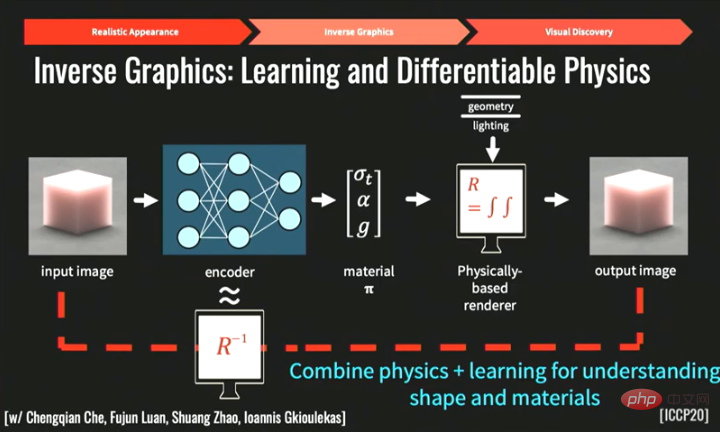
However, the recovery of shapes and materials is very difficult. The above process requires the rendering engine R to be differentiable. Many recent studies have Studying this issue.
If we want to be able to restore the visual effect of a product like a scene in a movie, we need to have a differentiable rendering pipeline, which means we need to be able to differentiate about Loss of the property you want to restore. Here is an example of recovering material and geometry, we can use the chain method to simply sample on the edges of the surface to get the information we need.
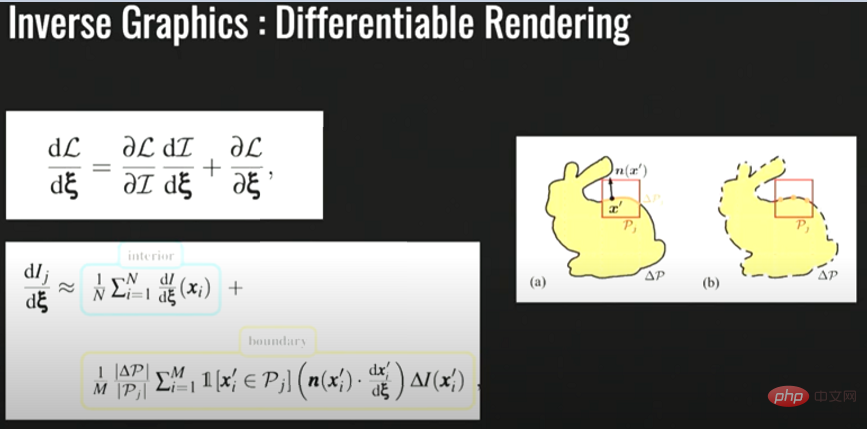
Then we can come up with a process for restoring the visual effects of objects as shown below. First, we can use a mobile phone to take a series of pictures of the object we want to restore, then initialize the pictures, optimize the material and shape, and then optimize again through differentiable rendering. Finally, the object can present a realistic simulation effect. Can be used in augmented reality/virtual reality and other applications.

In visual simulation, subsurface scattering is a very important phenomenon. The picture below is a work by multiple artists called Cubes ( square). These are actually squares with a side length of 2.5cm made from 98 kinds of food. The surface of each of the 98 foods is different and complex, which piqued our interest in exploration.
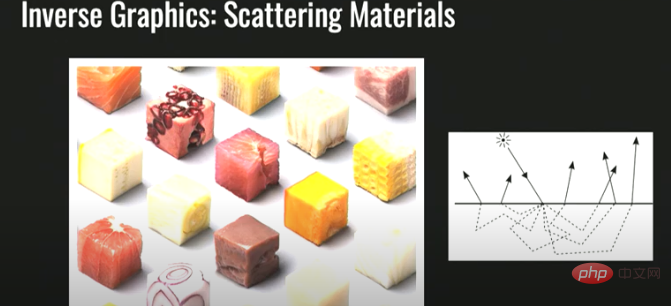
#Since the surface of food is very complex, subsurface scattering must be taken into account when restoring the properties of raw materials. The specific content in this regard will be As presented in our later paper, we have developed a fully differential rendering pipeline. What we use this pipeline to recover are material properties centered on subsurface scattering. Finally, we restored the different materials and shapes of these two fruits, and successfully presented the visual effects of kiwi and dragon fruit cubes.

Illustration: Process of restoring kiwi and dragon fruit cubes
In the above research, we used a combination of learning and physics, and summarized the following three points of importance.
- Understand visual phenomena;
- Before restoring the visual effect of an object, first predict the visual effect it presents;
- User control.
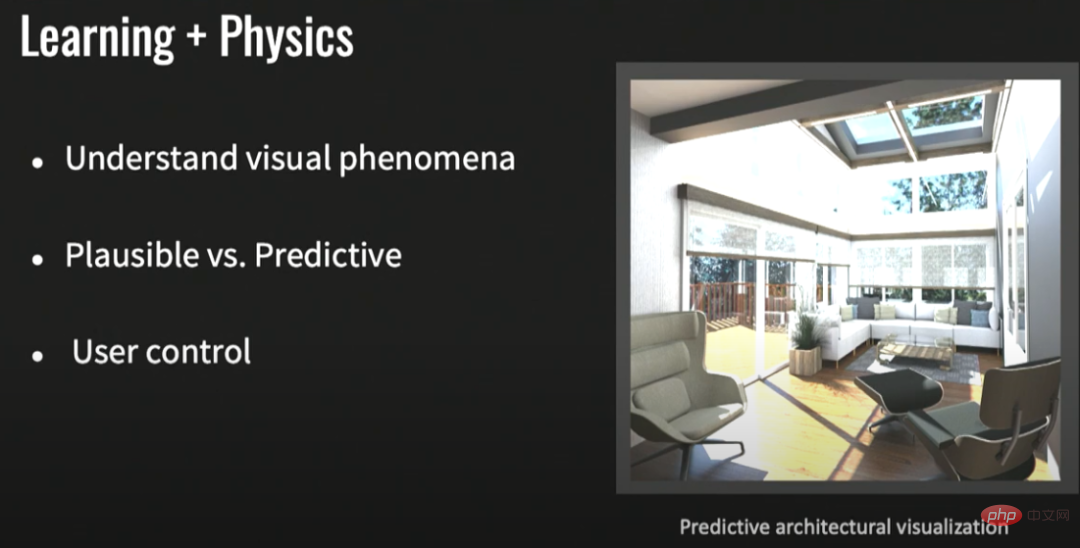
##3 World-scale visual discovery
I still remember the protagonist walking on the street in the movie On the scene, he looks at the products in the window, and then the visual interface tells him all the information about the objects he sees?
This is Fine-grained object recognition (Fine-grained object recognition) is a large research field in computer vision. Fine-grained object recognition is in It has been applied in many industries such as product identification and real estate.

Caption: Precise information provided by fine-grained object recognition
For example, in this picture, fine-grained object recognition can tell that this person is carrying an x. This x does not refer to a handbag (most people can tell this), but here x refers to a specific brand of handbag. , this kind of precise knowledge is beyond the reach of most ordinary people.
Essentially, we can provide expert-level information through visual recognition, or even expert-level information in more than one field, and I think the research in this area is very exciting.

This picture shows a campfire stove. Maybe some people can’t determine the purpose of this object just by sight, but in detail Granular object recognition can not only tell us that this is a campfire stove, but also provide information about the name of the artwork, where it can be purchased, and the artist who designed it.

Illustration: IKEA APP
We are at IKEA This usage method has been launched in the augmented reality APP. We integrated visual recognition and virtual rendering in the augmented reality APP. From then on, our past ideas about visual interfaces began to gradually become a reality.
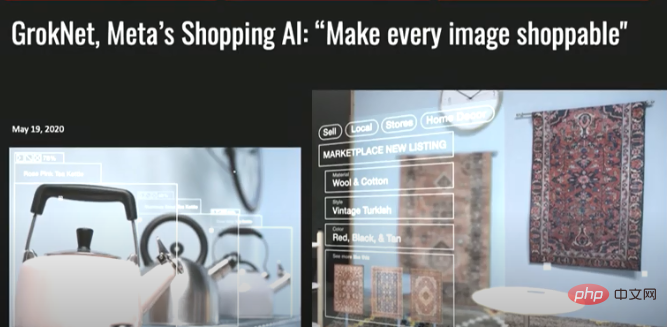
Note: The interface of Meta’s shopping AI GrokNet
Tu’s research is actually part of Meta’s shopping AI “GrokNet”. The slogan of GrokNet is to make every image lead people to shop (shoppable), and the goal of my research team and I is to make every image understandable (understandable).

What I have said above are some relatively basic research, and what we are doing now is collecting visual information on an unprecedented scale, including photos, videos and even Satellite imagery. The number of our satellites has grown significantly over the years. There are now about 1,500 satellites. These satellites upload 100 terabytes of data every day. If we can understand satellite images, then we can understand the direction of the entire world, and Knowing what is going on in the world is a very exciting research direction.

Caption: Can we understand pictures from a world scale?
#If we can understand the picture from the world level, then we can answer these questions on the picture: How should we live? What do we wear? What to eat? How does our behavior change over time? How has the Earth changed over time?
#So we started working on this question with anthropologists and sociologists, who were fascinated by these questions. , it just lacks a powerful tool to conduct research. One of the anthropologists we worked with was very interested in how clothing changed around the world, and we found that this question had many connections.
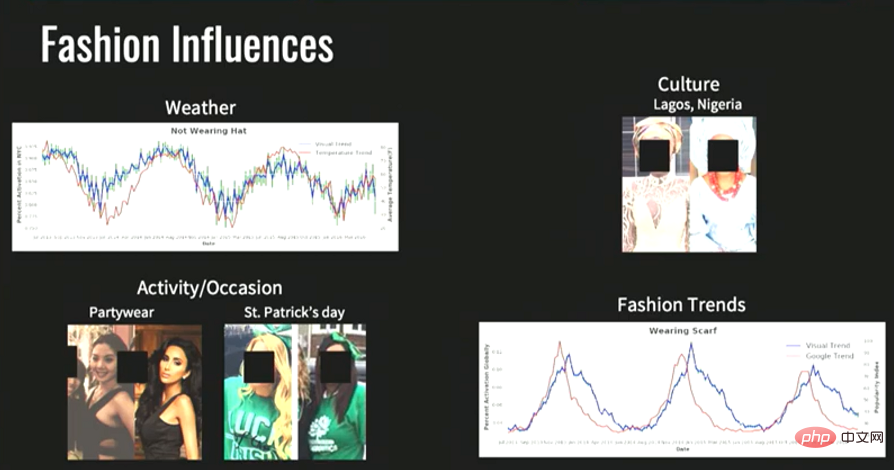
Why do people in different regions on the earth dress differently? We think there are several reasons:
- Weather is a very important reason. We dress differently from people in California in the summer because the weather here is warmer than in California. Cool;
- Attending parties or sports events, various activities or occasions also require people to wear specific clothing;
- Cultural differences will make Clothes vary across the world;
- Fashion trends are also an influencing factor.
So we started looking into this problem and started analyzing a set of about 8 million images of people from all over the world. We invented a simple recognition algorithm to identify what clothes people are wearing, which includes 12 attributes.
And what did we discover from this research?

We can see certain patterns from our analysis. For example, the people in the upper right corner have a tendency to wear green clothes, while those in the lower left corner People tend to wear red clothes.
Through the analysis of big data, we found that some data are consistent with our presets. For example, the weather does affect people’s clothing. People choose to wear thick clothes in winter and wear cool clothes in summer. , this is logical; but in some aspects, there are some strange data phenomena. As shown in the figure below, in Chicago over the past few years, there were several points in time that were the peak of people choosing to wear green.
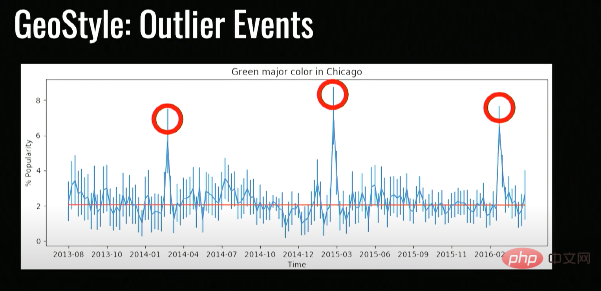
These time points are all in March every year. After investigation, it turns out that these time points are St. Patrick’s Day in Chicago:
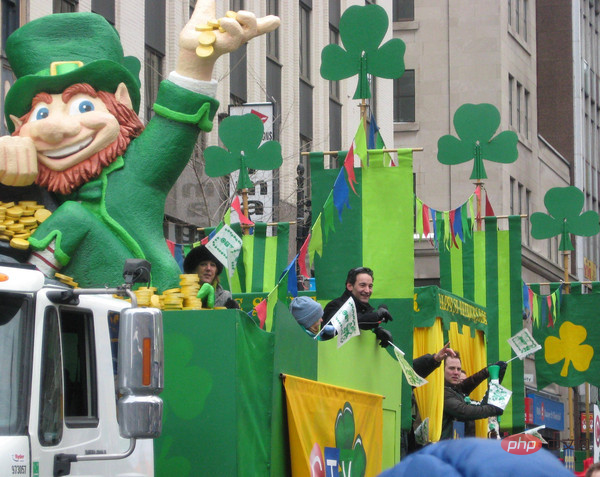
This is a very important local festival, and people in Chicago will choose to wear green on this day. If you are not a local, you may not know about this cultural event.
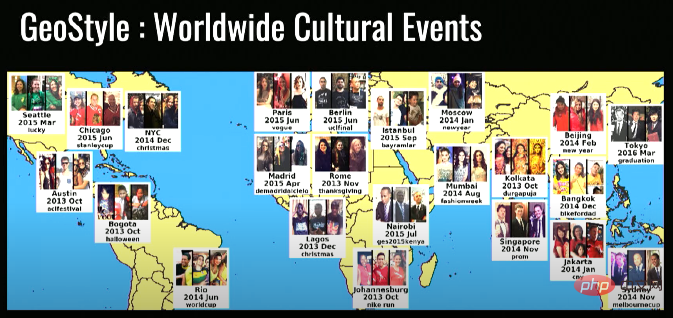
Note: Cultural activities valued around the world, people will wear different colors of clothing for these activities
By identifying people’s clothing changes in big data, we can understand local cultural/political activities and thus understand different regional cultures around the world. The above is how we understand the meaning of picture information from a world perspective.
Original video link: https://www.youtube.com/watch?v=kaQSc4iFaxc
The above is the detailed content of Kavita Bala, Dean of Cornell School of Computing: What is the 'Metaverse”? God's Eye may be born through AI. For more information, please follow other related articles on the PHP Chinese website!

Hot AI Tools

Undresser.AI Undress
AI-powered app for creating realistic nude photos

AI Clothes Remover
Online AI tool for removing clothes from photos.

Undress AI Tool
Undress images for free

Clothoff.io
AI clothes remover

Video Face Swap
Swap faces in any video effortlessly with our completely free AI face swap tool!

Hot Article

Hot Tools

Notepad++7.3.1
Easy-to-use and free code editor

SublimeText3 Chinese version
Chinese version, very easy to use

Zend Studio 13.0.1
Powerful PHP integrated development environment

Dreamweaver CS6
Visual web development tools

SublimeText3 Mac version
God-level code editing software (SublimeText3)

Hot Topics
 1662
1662
 14
14
 1418
1418
 52
52
 1311
1311
 25
25
 1261
1261
 29
29
 1234
1234
 24
24
 How much is Bitcoin worth
Apr 28, 2025 pm 07:42 PM
How much is Bitcoin worth
Apr 28, 2025 pm 07:42 PM
Bitcoin’s price ranges from $20,000 to $30,000. 1. Bitcoin’s price has fluctuated dramatically since 2009, reaching nearly $20,000 in 2017 and nearly $60,000 in 2021. 2. Prices are affected by factors such as market demand, supply, and macroeconomic environment. 3. Get real-time prices through exchanges, mobile apps and websites. 4. Bitcoin price is highly volatile, driven by market sentiment and external factors. 5. It has a certain relationship with traditional financial markets and is affected by global stock markets, the strength of the US dollar, etc. 6. The long-term trend is bullish, but risks need to be assessed with caution.
 Which of the top ten currency trading platforms in the world are among the top ten currency trading platforms in 2025
Apr 28, 2025 pm 08:12 PM
Which of the top ten currency trading platforms in the world are among the top ten currency trading platforms in 2025
Apr 28, 2025 pm 08:12 PM
The top ten cryptocurrency exchanges in the world in 2025 include Binance, OKX, Gate.io, Coinbase, Kraken, Huobi, Bitfinex, KuCoin, Bittrex and Poloniex, all of which are known for their high trading volume and security.
 What are the top currency trading platforms? The top 10 latest virtual currency exchanges
Apr 28, 2025 pm 08:06 PM
What are the top currency trading platforms? The top 10 latest virtual currency exchanges
Apr 28, 2025 pm 08:06 PM
Currently ranked among the top ten virtual currency exchanges: 1. Binance, 2. OKX, 3. Gate.io, 4. Coin library, 5. Siren, 6. Huobi Global Station, 7. Bybit, 8. Kucoin, 9. Bitcoin, 10. bit stamp.
 Which of the top ten currency trading platforms in the world are the latest version of the top ten currency trading platforms
Apr 28, 2025 pm 08:09 PM
Which of the top ten currency trading platforms in the world are the latest version of the top ten currency trading platforms
Apr 28, 2025 pm 08:09 PM
The top ten cryptocurrency trading platforms in the world include Binance, OKX, Gate.io, Coinbase, Kraken, Huobi Global, Bitfinex, Bittrex, KuCoin and Poloniex, all of which provide a variety of trading methods and powerful security measures.
 Decryption Gate.io Strategy Upgrade: How to Redefine Crypto Asset Management in MeMebox 2.0?
Apr 28, 2025 pm 03:33 PM
Decryption Gate.io Strategy Upgrade: How to Redefine Crypto Asset Management in MeMebox 2.0?
Apr 28, 2025 pm 03:33 PM
MeMebox 2.0 redefines crypto asset management through innovative architecture and performance breakthroughs. 1) It solves three major pain points: asset silos, income decay and paradox of security and convenience. 2) Through intelligent asset hubs, dynamic risk management and return enhancement engines, cross-chain transfer speed, average yield rate and security incident response speed are improved. 3) Provide users with asset visualization, policy automation and governance integration, realizing user value reconstruction. 4) Through ecological collaboration and compliance innovation, the overall effectiveness of the platform has been enhanced. 5) In the future, smart contract insurance pools, forecast market integration and AI-driven asset allocation will be launched to continue to lead the development of the industry.
 What are the top ten virtual currency trading apps? The latest digital currency exchange rankings
Apr 28, 2025 pm 08:03 PM
What are the top ten virtual currency trading apps? The latest digital currency exchange rankings
Apr 28, 2025 pm 08:03 PM
The top ten digital currency exchanges such as Binance, OKX, gate.io have improved their systems, efficient diversified transactions and strict security measures.
 Recommended reliable digital currency trading platforms. Top 10 digital currency exchanges in the world. 2025
Apr 28, 2025 pm 04:30 PM
Recommended reliable digital currency trading platforms. Top 10 digital currency exchanges in the world. 2025
Apr 28, 2025 pm 04:30 PM
Recommended reliable digital currency trading platforms: 1. OKX, 2. Binance, 3. Coinbase, 4. Kraken, 5. Huobi, 6. KuCoin, 7. Bitfinex, 8. Gemini, 9. Bitstamp, 10. Poloniex, these platforms are known for their security, user experience and diverse functions, suitable for users at different levels of digital currency transactions
 How to understand DMA operations in C?
Apr 28, 2025 pm 10:09 PM
How to understand DMA operations in C?
Apr 28, 2025 pm 10:09 PM
DMA in C refers to DirectMemoryAccess, a direct memory access technology, allowing hardware devices to directly transmit data to memory without CPU intervention. 1) DMA operation is highly dependent on hardware devices and drivers, and the implementation method varies from system to system. 2) Direct access to memory may bring security risks, and the correctness and security of the code must be ensured. 3) DMA can improve performance, but improper use may lead to degradation of system performance. Through practice and learning, we can master the skills of using DMA and maximize its effectiveness in scenarios such as high-speed data transmission and real-time signal processing.



